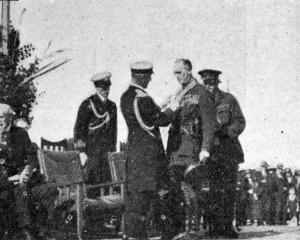''... Chaplain-captain Thornton has just been along, and is doing all he can for the New Zealanders. He says the casualties are going to be enormous. We brought 1000 on our boat, and 50 died on the way ...It is quite possible the New Zealanders and Australians will have to be withdrawn (if the movement has gone well) to reorganise.
The arrangements for handling the thousands of wounded are marvellous, and it is worth getting wounded to get the treatment and experience.
The strain of the last three months and a-half on Gabe Tepe has been very great on all who were there from the start, and great numbers cracked up from sickness ...When our machine gun section went into action the day after landing we numbered 40.
That is, four guns with 10 men to each gun. We have included in the 40 two sergeants, two corporals, and a lieutenant.
After the first week in action we had lost one officer killed, both corporals killed, one sergeant killed and the other wounded, and three privates killed and seven wounded, making our loss 15 out of 40.''
Paris: Details are to hand of the execution of Belgians at Liege on June 8.
A woman denounced 25 others for giving information to the Allies.
One woman was persuaded to confess on a promise that the culprits would be treated leniently; nevertheless 11 were sentenced to death.
Volunteers were called to form firing squads, but none was forthcoming.
Men were then chosen under threats.
The condemned arrived in wagons at daybreak, accompanied by priests, and were placed with their backs to a wall.
Posts were driven in the ground, and to these they were tied if their courage failed.
Louise Frenay was ordered to be shot first. The soldiers hesitated.
They had been unaware that they had to shoot a woman, and when ordered to fire some aimed to the side and some low.
The result was that the woman was wounded in the legs.
An officer ordered the men to reload, but the men flatly refused.
The officer then called up a non-commissioned officer, who shot the woman with his revolver.
The rest of the sentences were rapidly carried out.
The sealing schooner Gisborne had returned to Bluff from her annual cruise round the West Coast Sounds.
She had very indifferent luck, however, and bagged only 20 skins. She brought back a big quantity of fish - about 12 tons of cod - and that will pay much better than the result of their sealing operations.- ODT, 8.10.1915.












